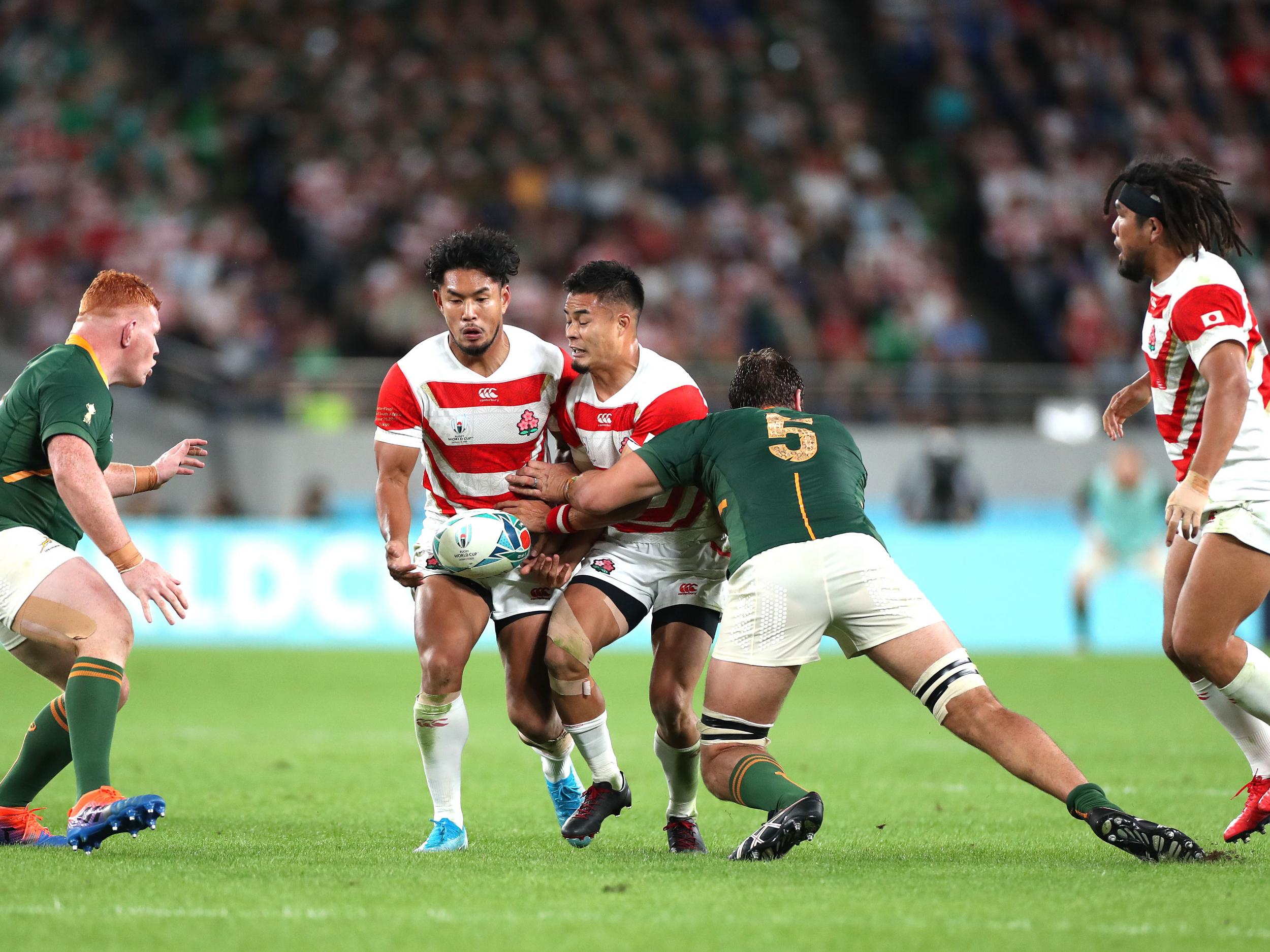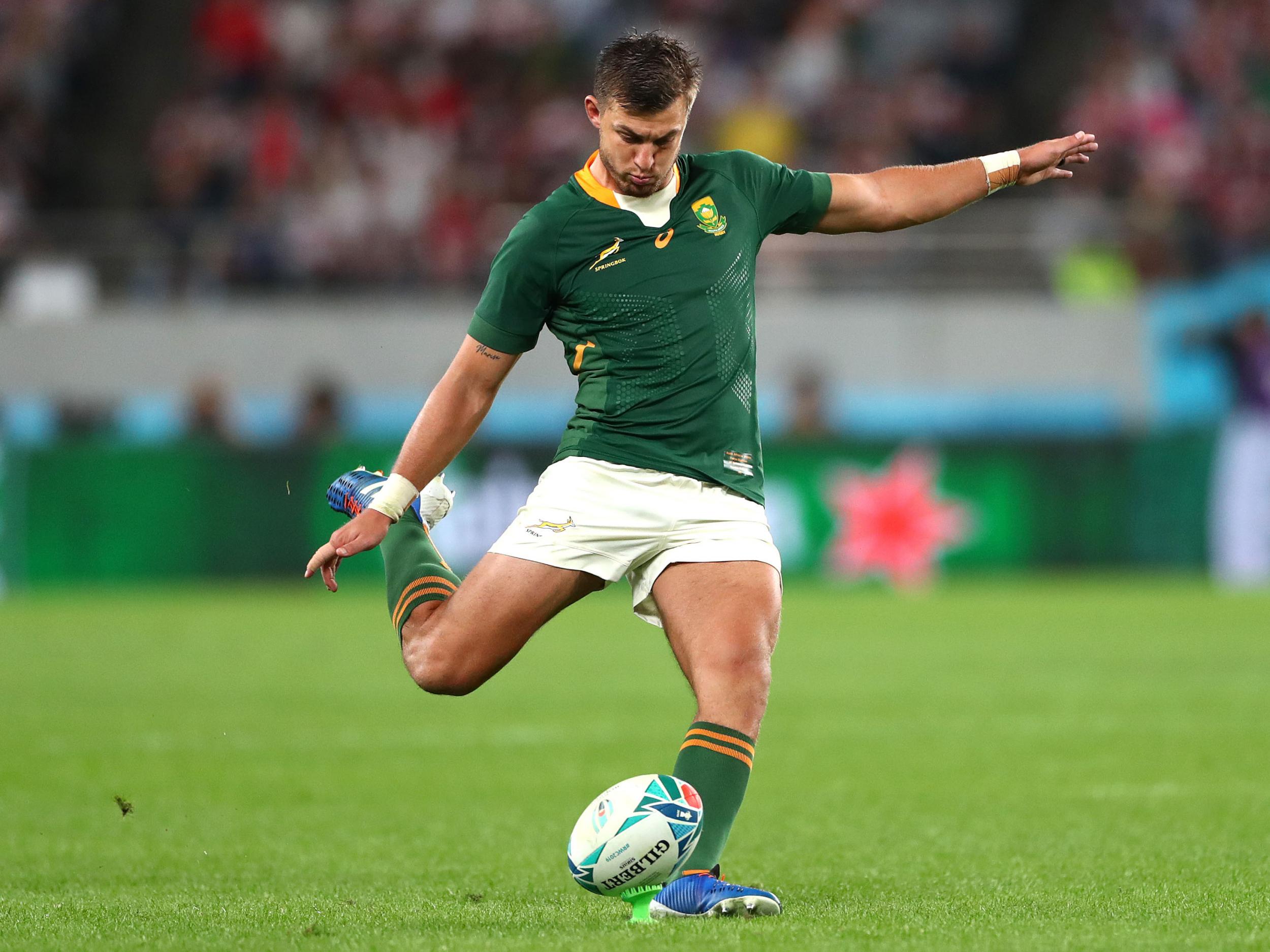Japan vs South Africa, Rugby World Cup: Five things we learned as Springboks’s fierce defence lays platform for win
South Africa’s ferocious defence shut down Japan’s effervescent attack to move on to a semi-final against Wales

Your support helps us to tell the story
From reproductive rights to climate change to Big Tech, The Independent is on the ground when the story is developing. Whether it's investigating the financials of Elon Musk's pro-Trump PAC or producing our latest documentary, 'The A Word', which shines a light on the American women fighting for reproductive rights, we know how important it is to parse out the facts from the messaging.
At such a critical moment in US history, we need reporters on the ground. Your donation allows us to keep sending journalists to speak to both sides of the story.
The Independent is trusted by Americans across the entire political spectrum. And unlike many other quality news outlets, we choose not to lock Americans out of our reporting and analysis with paywalls. We believe quality journalism should be available to everyone, paid for by those who can afford it.
Your support makes all the difference.1. Japan’s early ambition comes unstuck
Japan have captured the attention and adoration of the rugby world with their commitment to playing attacking rugby and their appetite to go from deep. But they have chosen their moments well during the World Cup, and have not been afraid to exit more conventionally when there is not the opportunity to play.
Here they were guilty of trying to do too much too soon. From the very first phase after the kick-off they launched a crossfield kick attempt inside the 22, but the wing was well marked, and Makazole Mapimpi nearly gathered for a simple score.
After another curious attempted exit went awry, South Africa were handed a scrum on the 22-metre line. With the early ascendancy at the set piece, Mapimpi was handed the ball confronted by just one defender in a fifteen metre channel.
In their attempts to protect slight fly-half Yu Tamura from big carriers like Duane Vermeulen at the base and Damian de Allende on the hard line in midfield, Japan pushed their ten out wide to cover the blindside wing. It was a smart idea in theory, but the rapidly retreating scrum tied in the flankers and left Tamura on an island with the dangerous Mapimpi.
Failing to close the space and on the back foot as he tried to follow the weave of the wing, Tamura went too high in an attempt to hold the player up for support to chop him down, allowing Mapimpi to brush him away all too easily and rattled over to get South Africa off to the perfect start.
2. Barnes’ yellow card decision too hasty?
Wayne Barnes is the best referee in the world, combining an empathetic style with clear communication to make the games he is in charge of better to watch without compromising either the laws of the game or player safety.
He is a referee who is confident in his decisions, sometimes to a fault. When Tendai Mtawarira lifted Keita Inagaki and the tackle went beyond the horizontal, Barnes was definite in his decision, choosing not to consult the TMO and producing the yellow card.
Mtawarira was perhaps lucky Barnes was so forthright. Inagaki appeared to land on his head or neck, which would meet the threshold for a red card, with the duty of care lying with the tackler and Mtawarira not attempting to bring his opposite number down safely.
A yellow card it was, and South Africa only had to survive ten minutes without their loosehead rather than 70. On balance, it was probably just about the right call, with Inagaki’s shoulder perhaps first to hit the floor, but other referees might have seen it differently, and the challenge looked worse in slow motion – it is conceivable that TMO Rowan Kitt might have advised Barnes to give a red card had he been consulted.
3. South Africa’s defence shuts down dynamic Japan
If South Africa are to win this World Cup, it will be built on their defence. It is a well-drilled and cohesive unit designed by defence coach Jacques Nienaber, with a fast outside blitz designed to direct play back into heavy-hitting forwards inside. Lukhanyo Am is a sharp decision-maker at 13, constantly challenging the playmakers of the opposition by rushing up, cutting off the play along the hands and forcing any wide passes to be risky or rushed.
New Zealand showed how to break down such a system in the pair’s opening pool fixture, kicking the ball wide early or changing the point of emphasis quickly tighter in close to the gain line, and at times Japan’s magnificent offloading game threatened to properly puncture the South African structure as they followed the All Blacks’ blueprint.
But in the 22, Japan struggled to break through with the pitch compacted and spaces smaller. They had nearly 70% of possession and territory in the first half, but failed to notch more than a solitary penalty as South Africa’s defence held firm.
It worked exactly as designed – Japan’s attempts to shift the ball wide were nullified by Am and co. on the outside blitz, and as runners were forced back inside they were met by punishing tackles to stall any momentum Japan had, most notably when Duane Vermeulen crunched his man five metres from the South African line. By winning the collision, the Springboks were able to attack the breakdown, slow the ball and force Japan to put extra men in and win the ball back.

That left the next ruck area under-resourced, and Damian de Allende jackaled and won the penalty for holding on. Japan again played plenty of excellent rugby, but South Africa’s superb structures in defence limited their scoring potential, and laid the platform for the Springboks’ victory.
4. South Africa’s errors in attack keep it close
For a side that pride themselves on accuracy in attack, South Africa were strangely haphazard in their movements, particularly close to the line. Dropped balls, forward passes, Damian de Allende failing to heed the warning of Wayne Barnes that he had just been held in the tackle – the Springboks butchered several tries during the first 50 minutes.
Am offloaded at the feet of an unmarked Mapimpi when a simple pass would have done, while Willie Le Roux eschewed the chance to go through the hands of Siya Kolisi with an overlap to instead whip a miss pass at least a metre forward to Pieter-Steph du Toit. Japan failed to capitalise on South Africa’s mishaps, though, and Handre Pollard kept the scoreboard ticking over to keep Japan at just about arm’s length. But in contests to come the South Africans will have to be more accurate in the 22, and take the scoring chances when they come, though they did pull away in the final 20 minutes.
5. Handre Pollard’s solid yet unspectacular style suits South Africa just fine

There are more creative tens than Handre Pollard at this tournament, more effervescent players with greater ability to beat a man, creators with a more complete skillset who can unlock defences in myriad ways. But there is no fly-half with his physical edge and solidity, and his uncomplicated style suits South Africa just fine.
Pollard is an accurate distributor and smart territorial kicker with a big boot, generally good from the tee and a player who thrives within structure, offering a carrying threat to hold inside defenders and a turn of pace if a hole presents itself.
He does not shirk the physical stuff in defence or attack, and that allows Am and de Allende to trust their inside cover, and engage such a fierce outside blitz.
While you would not pick Pollard to pilot a team built on speed, creativity in attack and ability to strike in transition – Finn Russell and Scotland, say – he is perfect for this South African side. It was from his break that Makazole Mapimpi scored his second try to truly seal the victory.
It was a shame to see Japan’s tournament end this way, for they have lit up the World Cup with their speed, their style, the joyful expression in attack. But they were beaten by a side perfectly built to counter Jamie Joseph’s team’s strengths, and, in the end, over-powered and well-beaten.
Join our commenting forum
Join thought-provoking conversations, follow other Independent readers and see their replies
Comments